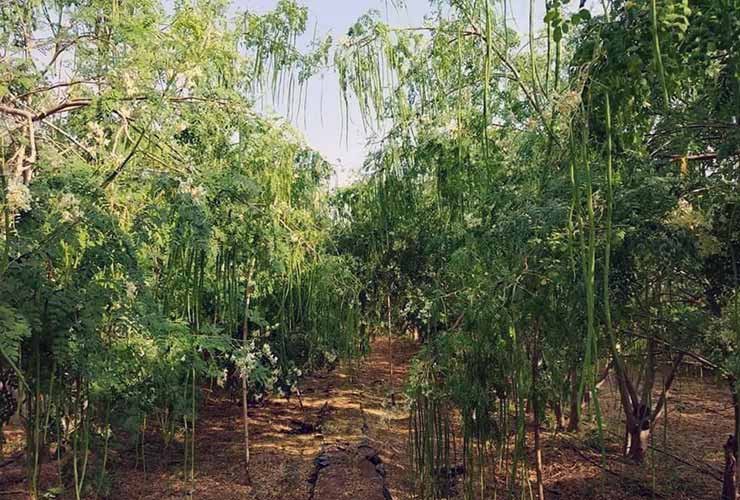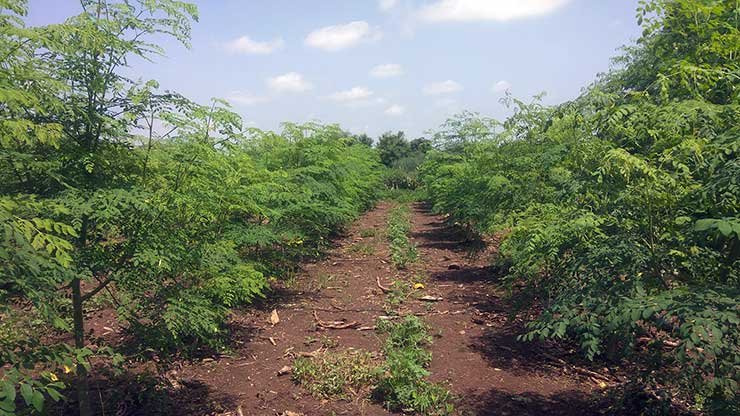Drumstick (Moringa oleifera) is a fast-developing, drought-resistant, deciduous plant native to tropical as well as subtropical areas of South Asia. Drumstick or moringa farming is getting increased popularity due to increasing demand. Drumstick fruits (pods) are used as vegetables and moringa leaves are used for making herbal cosmetics, medicines and water purification.
India is the largest producer of drumstick with its production capacity at the level of 1,30,00,00 tons annually which is an output of 93,916 acres of cultivated land. While Andhra Pradesh takes the leading role in producing drumsticks, it is followed by Tamil Nadu and Karnataka. It is grown more or less in almost all States in India.
Crop Overview
| Scientific Name | Moringa Oleifera |
| Common Name | Murugaikkai (Tamil), Munagakayalu (Telugu), Muringakka (Malayalam), Nuggekai (Kannada), Shevaga (Marathi), Sajane Danta (Bengali), Sajgan Shinga (Hindi), Sargavani shing (Gujarathi), Savonjna (punjabi), Sajana Chhuin (Oriya) |
| Soil | Drumstick is adaptive to diverse agro-climates, however, demonstrates superior performance when grown in well-drained sandy or loamy soil with an pH of 6.2 to 7.0. |
| Climate | The plant prefers exposure to sun and heat, while it’s prone to frosting and freezing. 300-2500 mm rainfall is ideal. Proper watering is a must in areas with less than 800 mm rainfall during leaf production season. |
| Plant Population | 480-600 plants per acre for normal plantation |
| Crop Type | Horticulture |

Uses of Drumstick

Drumstick is acknowledged as a powerhouse of high nutritional value. Its leaves, seed pods or fruits, flowers and roots are enriched in Vitamins A, C, Calcium, and all other minerals important for human health. The fruit is used as vegetable in Indian cuisine.
As per research moringa leaves contain 7 times more vitamin C available in oranges, 4 times calcium found in milk, 3 times potassium we get in bananas and 2 times protein found in milk. Aside from being extensively used for culinary purposes it has high demand in the medication industry with its great anti-anti-inflammatory and medicinal properties. Moringa leave is sold in powder form or as capsules or tablets.
Oils extracted from its kernels are used for preparation of foods, cosmetics and in making different machine oils.
Drumstick Farming Step by Step
1. Selection of Drumstick Variety
There are many varieties of drumsticks in India. Most of the varieties are suitable for fruit production except a few handful ones which gives better leaf production.
- Coimbatore 1: Developed by Kerala Agricultural University, it is a superior variety of drumstick that measures nearly 45-60cm long. The plant offers yearly two harvests and can continually produce yield up to 8-10 years.
- Coimbatore 2: Another popular variety that has more demand among cultivators in Tamil Nadu. Drumsticks grow shorter in size (25-35cm long) with bulky pods and offer higher yield.
- CO 2: Developed by Tamil Nadu, the variety grows about 30-35 cm in length and offers yield of 350 pods per plant yearly.
- Rohit 1: Pod length is 50-60 cm and yields about 135 pods per plant/year. It can be harvested twice yearly.
- PKM 1: The plant has capacity to yield nearly 220-250 pods per plant and is ready for harvesting in 9 months. It offers a POD length of 70cms and its lifetime is 5 years. It is another variety that provides two harvests yearly.
- PKM 2: Developed by Tamil Nadu, the plant can yield nearly 400 pods/ per plant yearly or 340 tons per acre. Length of pods is 60-70 cm.
2. Field Preparation
Land must be well-ploughed to attain full tilth. Pits should be dug measuring 1ft x 1ft x 1ft keeping a distance of 2.5-3 m during summer. With this, you can plant seedlings at the beginning of monsoon, which is the proper time of sowing. Fill up pits with FYM@5 kg mixing with the topsoil. About 1200- 1500 plants can be grown per hectare of land.
3. Propagation

Propagation of drumstick plants can be done effectively through sowing seeds or planting of cuttings also called as vegetative propagation, nonetheless with vegetative means, you can get high quality plants with increased yield. In this case, plant cuttings should be chosen diligently considering the parent plant’s performance history. Have an eye to ensure that plants you choose that are disease free, 100% lively and have a high yielding record. The desired length of cuttings should be 11⁄2 m with 5 cm diameter. 1/3 rd of part of the cuttings should be kept in a well ventilated, pest free nursery soil while regular watering once a day helps in root formation. Alternatively, you can use polythene bag mixing with topsoil and sand in 3:1 ratio, a little amount of superphosphate and FYM. Water the bag and accordingly the cuttings will emerge as seedlings with roots.
4. Transplantation
As seedlings become 70-90 cm in height, they are ready to be transplanted in the main field. Cultivators can use 1000-1250 seeds per acre land @ 2 seeds in a pit. 2.5 x 3 metres plant-to-plant spacing for normal plantation and 1.5 x 1.5 metre for high density plantation is followed.

5. Manure and Fertilisers
Ideally, those who follow drip irrigation consider applying N: P: K @ 135: 23: 45 gm/ pit every day through a dripping system to fetch desired yield. Additionally, application of N: P: K @ 45: 15: 30 grams/ pit after 3 months and after six months of showing a dose or N@ 45 gm per pit is vital.
6. Pruning and Weeding
Once seedlings gain a height of 60-90 cm height, pinch it 10 cm below its tip. With this, plants develop several lateral branches within a week. Once again, as those side branches reach a length of 40-60 cm, pinch their top. Because doing this will encourage plants to grow with more branches which means more pods and increased yield. With pinching you can keep your plants growing compact, fuller, and make them a higher yield producer. Practice 4 pinching in the first three months of the growing stage.
Also, controlling weeds is vital to let your principal plant nurture with full nutrition from soil, water, and sun without having a shadow. Use of non-toxic herbicides is a good choice to control weeds. Equally, consider elimination of injured, broken, or dead branches of plants from time to time to foster absolute growth.
7. Inter cropping
Before the plants start growing at full pace and providing yield, intercropping with vegetables of short duration happens to be beneficial. This practice also helps in control of weeds.
8. Irrigation
By nature, drumstick plants require less amount of water and because they’re drought-resistant, they are empowered to provide yield but in a less quantity. By following proper advanced drip irrigation management for watering and fertilising plants, potential cultivators can maximise plant output. Plants need to be irrigated in the seedlings stage in the nursery bed as well as after showing for faster growth.
Pests Management in Moringa Plantation
Leaf caterpillar
The larvae eat leaves of the plants and harm their growth. Apart from destroying them from leaflets clusters, use Malathion-50 EC spray @ 2 ml after mixing with per litre water to control pest attack.
Bud worm
The pests feed on the buds, flowers and destroy them and thus, stop forming pods. Consider spraying plants with Malathion 50 EC @ 2.5 litres/ acre.
Hairy caterpillar
The pest is extremely damaging for the plants and to control use Spray of Carbaryl-50 WP@ 2 gm/ litre water to get the best result.
Pod fly
Maggots developed from eggs feed on the pods resulting in drying of the tip portion with pod discharge. Fallen pods must be destroyed while applying Nimbecidine @ 3 ml / litre of water in the early stage of pod formation and once more after 30 days works effectively to stop pod fly infestation.
Harvesting and Yield
Cultivators farming drumstick plants or Moringa oleifera can earn enormously from its fruits (pods), leaves, and kernels which are all having high market value. Depending on the variety, climatic conditions, fertilisation and other favourable factors, yields widely vary. Consider using sharp knives, stabs attached with hooks or sickles in the course of harvesting.
Fruits (pods)
Typically, whereas plants are grown through vegetative propagation i.e. from cuttings, you can naturally expect first harvesting within 6–8 months after planting, which extends over a year when planting is done through seed. In north India, fruits are harvested during summer while in South India, flowers appear twice a year enabling two harvesting (in July-Sept) and (Mar-April). Initially for the first two years, plants can produce 300 pods which will increase up to 500 in next three years. In Indian condition, yearly 31 tons of pods per hectare can be produced. Many hybrid species have the capacity to provide a yield of 800-1000 pods per plant yearly.
Leaves
The amount of yield among rainy and summer season harvesting differs like 1150 kg/ ha and 700 kg/ ha respectively. On an average, yearly expected yield is likely to be 6 tons/ha under good condition.
Oil
As said above kernels are used to extract oil for various purposes, cultivators can expect a yield of producing 250Liter oil/ per ha from production of kernels.
